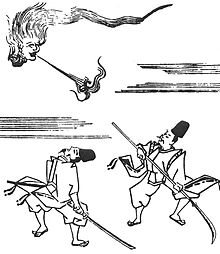Ubagabi


Theubagabi( mỗ ヶ hỏa[1]or mỗ hỏa,[2]"old woman's fire" ) is anatmospheric ghost lightin legends ofKawachi Province(now Osaka Prefecture) andTanba Province(now northernKyoto Prefecture). They are mentioned in old literature, such as theTenpōperiod book theShokoku Rijin Dan(Chư quốc người nói)[2]andIhara Saikaku's collection of miscellaneous tales theSaikaku Shokoku Banashi(Tây hạc chư quốc ばなし)[3]as well as Edo periodkaidanbooks such as theKokon Hyaku Monogatari Hyōban( cổ kim trăm vật ngữ bình phán '),[4]theKawachi Kagami Meishōki(Hà nội giám danh sở nhớ),[5]andToriyama Sekien's collection of yōkai depictions, theGazu Hyakki Yagyō,among other mentions.[6]
Concept[edit]
According to theShokoku Rijin Dan,on a rainy night, in Hiraoka, Kawachi (nowHigashiōsaka,Osaka Prefecture), it would appear as a ball of fire with a length of one shaku (about 30 centimeters).[5]It is said that in the past, an old woman stole oil fromHiraoka Shrineand became a mysterious fire from a resulting curse.[2]
Once, when someone was walking along the road at night in Kawachi, the ubagabi suddenly appeared from nowhere and hit this person's face, and when this person looked closely, it took on the form of a chicken-like bird. It is said that when the ubagabi eventually flew away, it turned back into its original appearance as a ball of fire.[2]From this, the yōkai manga artistMizuki Shigerusuggested the possibility that the ubagabi was actually a bird.[7]
In the tale where an old woman became an ubagabi, theSaikaku Shokoku Banashi,it's written about here as the "Mi wo Sute Abura-tsubo (the oil pot that threw away its body)." According to this, the ubagabi is said to fly a length of about one ri (about four kilometers[8]) in a mere instant, and it's said when the ubagabi grazes around someone's shoulder, that person would die within three years. However, it's said that ubagabi would disappear if you say "abura-sashi" (meaning "oil pourer" ).[3][6]
There is also a legend about an ubagabi appearing at theHozu RiverinKyoto Prefecture.[1]In theKokon Hyaku Monogatari Hyōban,there was once an old woman who lived near Kameyama (nowKameoka,Kyoto Prefecture) who would receive money from parents, telling them that she would take them to meet people they needed to see, and put the children into the Hozu River. Eventually, perhaps as divine punishment, the old woman experienced a flood and drowned. After that, it is said that a mysterious flame would appear near Hozu River, and people called this the ubagabi.[4]
It is also titled "Ubagabi" (here written as mỗ が hỏa ) in theGazu Hyakki Yagyō,and it is depicted with an old woman's face within the mysterious flames, but since there is the statement "it's said to be in Kawachi Province" within accompanying description, this makes it a depiction of a Kawachi Province legend.[6]
Notes[edit]
- ^abGiang mã vụ (September 1933)."Yêu quái 変 hóa も の がたり".Hương thổ nghiên cứu phía trên.3(33 hào ( thông quyển 33 hào ) ). Phía trên hương thổ nghiên cứu sẽ: 5.Retrieved2015-08-27.
- ^abcdCúc cương dính lạnh (1975). "Chư quốc người nói". In sớm xuyên thuần Tam Lang hắn biên tập (ed.).Nhật Bản tuỳ bút đại thành.Vol. Đệ 2 kỳ 24. Cát xuyên hoằng văn quán. p. 473.ISBN978-4-642-08547-2.
- ^abGiếng nguyên tây hạc (1991). "Tây hạc chư quốc ばなし". In tá trúc chiêu quảng hắn biên (ed.).Háo sắc nhị đại nam tây hạc chư quốc ばなし bổn triều hai mươi bất hiếu.Tân Nhật Bản văn học cổ đại hệ. Nham sóng hiệu sách. pp. 382–384.ISBN978-4-00-240076-1.
- ^abSơn cương nguyên lân (1989). "Cổ kim trăm vật ngữ bình phán". In cao điền vệ biên ・ giáo trung (ed.).Giang hộ quái đàm tập.Nham sóng kho sách. Vol. Hạ. Nham sóng hiệu sách. p. 364.ISBN978-4-00-302573-4.
- ^abThôn thượng kiện tư biên (2005).Nhật Bản yêu quái đại sự điển.Kwai books. Giác xuyên hiệu sách. p. 46.ISBN978-4-04-883926-6.
- ^abcĐạo điền hết lòng tin theo ・ điền trung thẳng ngày biên, ed. (1992).Điểu núi đá yến họa đồ bách quỷ dạ hành.Cao điền vệ giam tu. Quốc thư phát hành sẽ. p. 54.ISBN978-4-336-03386-4.
- ^Thủy mộc しげる (2004).Yêu quỷ hóa.Vol. 3.Softgarage.p. 3.ISBN978-4-86133-006-3.
- ^Dân dã xảo (1997).Ảo tưởng động vật sự điển.Kỷ nguyên mới xã. p. 44.ISBN978-4-88317-283-2.
